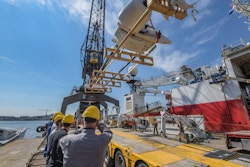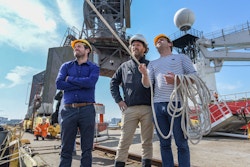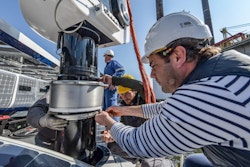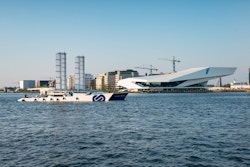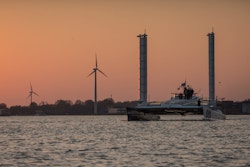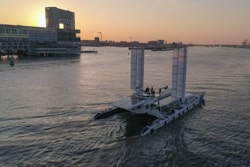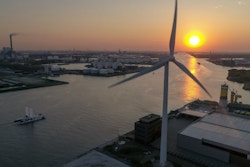Energy Observer integrates wind propulsion wings on board!
The 18th of was an expected and important day for Energy Observer, which has equipped itself with a new technological brick for wind propulsion: two Oceanwings®, rotating, self-supporting and 100% automated, which will increase the vessel’s speed and produce hydrogen during navigation by electrolysis of sea water. A technology never before tested on such a large boat, and which could well revolutionize maritime transport.
Energy Observer and VPLP, in search of a universal wind solution
Although it is an inexhaustible resource at sea, wind is still difficult to exploit for large-scale maritime transport. Energy Observer, as an experimental vessel, has set itself the task of testing all available and promising solutions. During the first navigation campaigns, Energy Observer tested 2 vertical axis wind turbines for energy production, and a traction wing for reducing energy costs.
The vessel is now testing a brand new system that combines the advantages of both: a wind-powered thruster. Oceanwings® will reduce the ship’s energy consumption, accelerate its speed but above all produce energy and hydrogen while sailing.
12 meter span
The largest Oceanwings® tested to date. They are the result of a concept patented by VPLP design co-developed in partnership with CNIM where they are assembled. Energy Observer will thus provide unprecedented feedback for the maritime transport of the future. The wings, with a surface area of 31.5 m² each, are self-supporting and can be rotated 360°.
VPLP Design draws its inspiration and experience from the rigid wings of the America’s Cup, whose aerodynamic efficiency is far superior to traditional sails. However, there is a fundamental reason that has limited their development: their rigidity. Until now, they had not had the capacity to reduce the surface area, in other words the arisage and lowering, as on a conventional rig.
With Oceanwings®, VPLP Design aims to offer a simple solution to overcome this obstacle and democratize the use of rigid wings.
“We wanted to offer a safe, simple and automatable wind propulsion system. We have therefore developed a concept of a collapsible and reusable rig, based on the aerodynamics of the multiple-element profiles of the Cup. With Energy Observer, the Oceanwings® project is moving to the demonstrator stage. For us, it is the validation of the industrial process carried out with CNIM. It is an intermediate phase between the prototype – which has worked beyond our expectations – and the series. We will also be able to discover how the coupled wings work, it will be interesting to work on.”
Thanks to Ademe, a complete functional prototype of 8 m span allowed to validate the feasibility of the wings, to make the systems more reliable and to complete the navigation surveys on the performance prediction models (VPP) developed internally. It is by sailing this prototype with Marc Van Peteghem, during the Odyssey for the Future of Energy Observer, that Victorien Erussard was conquered by technology.
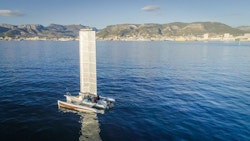
Energy Observer's Oceanwings
They will initially be covered with Hydranet, a resistant fabric capable of receiving a paint or varnish. Energy Observer engineers are working on selecting the best technologies for flexible photovoltaic panels to make them solar, thus capable of producing photoelectric energy.
A performance multiplier for the Energy Observer energy mix
On board the Energy Observer, the Oceanwings® will not only act as a rigging system, they will truly increase the ship’s performance. Their installation on the ship’s two floats should make it possible to:
- Accelerate speed, in addition to electric motors,
- Reduce energy costs when they relieve electric motors,
- Increase energy production during navigation through the production of hydroelectric power (inversion of electric motors to hydrogen generators)
- Produce hydrogen during navigation by electrolysis of water
This is one of the main advances for Energy Observer. Whereas until now hydrogen production was limited to stopovers, the Oceanwings® installation opens the way to hydrogen production during navigation. Only 1 to 2 hours per day at first, but by integrating hydrogenation through the conversion of electric motors, it is an essential energy supplement for Europe.
Up to 42% less energy consumption for global maritime transport
The installation of Oceanwings® on board Energy Observer is a first step in reducing the environmental impact of global shipping. According to simulations carried out on a very large panel of boats, the results are extremely promising: 18 to 42% less energy consumption. This is a significant figure when you consider that 90% of world trade is carried by sea. Maritime transport is also responsible for high air pollution by releasing pollutants such as fine particles, nitrogen oxides (NOx) and sulphur oxides (SOx) into the atmosphere.
“Beyond the pure technology, which we are eager to test on board as the system looks high-performance and automated, I deeply believe that these wings can represent a real technological breakthrough in reducing the energy costs of commercial vessels. Combined with hydrogen, it is the winning combo for clean shipping.”
A solution designed to be industrialized
Oceanwings®’s approach is based on economic profitability and responsible design. If wind propulsion allows a two-digit reduction in fuel consumption, it cannot require dedicated personnel; rigging automation is therefore essential. Industrialization, conceived from the design stage, makes it possible to offer a price comparable to that of a performance rig, which can be quickly amortized for professionals.
